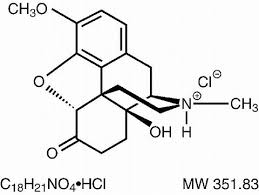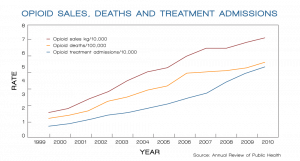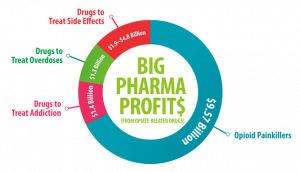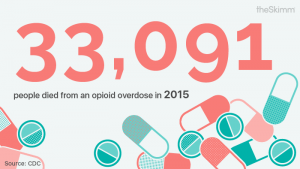Our nation is in the midst of an opioid epidemic that is spiraling downwards and has been since Purdue Pharma introduced OxyContin extended-release tablets in 1996. Although this advertisement is over 20 years old, I think it has a huge impact on our current crisis. I also chose to use a video that illustrates 5 people’s lives from 1998 when they started taking OxyContin to 2008 and how their lives have been affected. I chose to use this video because in 1998 Purdue Pharma used 7 people’s experiences with the drug in a promotional video directed at physicians that claimed OxyContin had saved these people’s lives.
Purdue Pharma is a privately owned pharmaceutical company that was founded in 1892 by two doctors John Purdue and George Frederick Bingham. In 1952 the company was sold to the Sackler Family and is still owned by this family. Based off the information found on Purdue Pharma’s website, Purdue started out as a small struggling business selling products such as Uniphyl (oral theophylline) used for asthma control, but they are known for their development of pain management medication. In particular their production of OxyContin. In 1987, they launched MS contin, in 1991 Purdue Pharma became a Limited Partnership and in 1993 they established Partners Against Pain to educate people on unnecessary suffering of chronic pain. In 1996 OxyContin extended-release was launched after the FDA approved the medication in 1995. According to Purdue’s ‘about’ section they state that, “We are committed to improving patients’ lives in meaningful ways by providing effective therapies along with educational tools that support their proper use.” (About Purdue, 2017) The company sells prescription and over-the-counter medicines (OTC) and they focus on six medical product categories. Their prescription medication includes prescription opioids and sleeping medication and their OTC drugs are laxatives, opioid induced constipation, antiseptics and dietary supplements. (For Healthcare Professionals. n.d.). This company has remained profitable over the years and currently has a net worth of $13 billion dollars. They are also recognized since 2015 as one of the richest families in America.
Based on my research, I assume the audience for this advertisement was most likely anyone over the age of 18 who was experiencing either chronic pain or cancer-related pain. However, I also believe the video was directed at other physicians during 1996 to influence their mindset about OxyContin and in particular that it had ‘low risk of addiction’ and that it is the ‘best’ pain medication. By marketing the product directly to doctors it would greater influence them to prescribe the medication to patients in pain. Purdue used a strong marketing campaign to gain attention of consumers and continued to use bold marketing strategies until around 2011. according to The National Center for Biotechnology Information (NCBI), Purdue used marketing data to influence doctors to prescribe. They compiled data from doctors nationwide to show prescribing patterns. With this information, Purdue was able to identify which doctors prescribed opioids most frequently but it also showed areas with large chronic-pain patients. This marketing campaign allowed Purdue to target individuals who were suffering chronic-pain. Also, in the video involving 7 individuals ‘then and now’, it shows Purdue’s efforts to market this pain medication to doctors. (Zee, A. V. (2009, February)
 OxyContin also known as Oxy or Oxycotton comes in forms of 10mg, 15mg, 20mg, 30mg, 40mg, 60mg, and 80mg and are supposed to taken orally. When used properly, it can help relieve pain associated with cancer and chronic pain. However, this drug is commonly misused and oftentimes abused, in which it is crushed and snorted or mixed with water and injected. If OxyContin is consumed in either of these ways it eliminates the ‘time-release’ factor and it allows the drug to rush directly into the body. According to the Rxlist website, the active ingredient found in OxyContin is Oxycodone, which “is a white, odorless crystalline powder derived from the opium alkaloid, thebaine.” (OxyContin: Side Effects, Interactions, Warning, Dosage & Uses. n.d.) The inactive ingredients found are butylated hydroxytoluene (BHT), hypromellose, polyethylene glycol 400, polyethylene oxide, magnesium stearate and titanium dioxide. According to the United Nations Office on Drugs and Crime, of the six opium alkaloids “Thebaine is the most poisonous opium alkaloid and is scarcely used medically.” (United Nations Office on Drugs and Crime. n.d.) Thebaine is 10 times stronger than morphine and is roughly 10 times as lethal, high doses can result in convulsions and psychological and physical dependence. (Thebaine. n.d.) This advertisement does not tell consumers that OxyContin is highly addictive, or that it is expensive and not all health insurance plans cover it, it does not inform consumers of what happens when they stop taking the drug or how to ween yourself off the painkillers. Overall, they do not inform the audience of any negative effects or attributes that come along with the use of OxyContin. According the the investigation and research done by the LA times, if there are gaps between pills, people can experience body aches, nausea and other withdrawal symptoms. (‘You want a description of hell?’ OxyContin’s 12-hour problem n.d.)
OxyContin also known as Oxy or Oxycotton comes in forms of 10mg, 15mg, 20mg, 30mg, 40mg, 60mg, and 80mg and are supposed to taken orally. When used properly, it can help relieve pain associated with cancer and chronic pain. However, this drug is commonly misused and oftentimes abused, in which it is crushed and snorted or mixed with water and injected. If OxyContin is consumed in either of these ways it eliminates the ‘time-release’ factor and it allows the drug to rush directly into the body. According to the Rxlist website, the active ingredient found in OxyContin is Oxycodone, which “is a white, odorless crystalline powder derived from the opium alkaloid, thebaine.” (OxyContin: Side Effects, Interactions, Warning, Dosage & Uses. n.d.) The inactive ingredients found are butylated hydroxytoluene (BHT), hypromellose, polyethylene glycol 400, polyethylene oxide, magnesium stearate and titanium dioxide. According to the United Nations Office on Drugs and Crime, of the six opium alkaloids “Thebaine is the most poisonous opium alkaloid and is scarcely used medically.” (United Nations Office on Drugs and Crime. n.d.) Thebaine is 10 times stronger than morphine and is roughly 10 times as lethal, high doses can result in convulsions and psychological and physical dependence. (Thebaine. n.d.) This advertisement does not tell consumers that OxyContin is highly addictive, or that it is expensive and not all health insurance plans cover it, it does not inform consumers of what happens when they stop taking the drug or how to ween yourself off the painkillers. Overall, they do not inform the audience of any negative effects or attributes that come along with the use of OxyContin. According the the investigation and research done by the LA times, if there are gaps between pills, people can experience body aches, nausea and other withdrawal symptoms. (‘You want a description of hell?’ OxyContin’s 12-hour problem n.d.)
As stated by the World Health Organization, direct-to-consumer advertising has been legal since 1985, it was not until 1997 that these advertisements started to bombard society. Direct-to-consumer advertising under fire. n.d.) According to Hanson, G. R., Venturelli, P. J., & Fleckenstein, A. E. (2015), the total spending on advertisement increased from $11.4 billion to $29.9 billion from 1996 to 2005. (Page 110) In the Purdue advertisement provided, Alan Spanos M.D. claims that the risk of addiction among patients treated for pain is less than 1%, and continues to claim that this Oxycontin should be used much more often because it is the best, strongest pain medication. According to the Centers for Disease Control, Opioids (prescription, heroin and fentanyl) accounted for more than 33,000 deaths in 2015, they also claim that around half of opioid overdoses are from prescriptions. (Opioid Overdose. (2017, October 23). Based off the press release in 1996 following the launch of OxyContin, Purdue Pharma claimed that “OxyContin Tablets are taken every 12 hours, providing smooth and sustained pain control all day and all night.” (OxyContin Press Release, 1996.) In 2016, The LA Times investigated Purdue Pharma and found that, before OxyContin went into market, clinical trials showed that many people were not feeling relief for 12 hours as it claimed. Purdue strives to remain profitable and without their 12 hour relief claim, they have very little competitive advantage over other painkillers. Despite the fact that the higher the potency the higher the risk, the company continues to market this product as a 12-hour relief, instead of offering lower doses more frequently. Theodore J. Cicero, a neuropharmacologist, says that OxyContin 12-hour interval has potential to be the “perfect recipe for addiction”. (‘You want a description of hell?’ OxyContin’s 12-hour problem n.d.) The fact that there is evidence showing Purdue Pharma was aware that their pills did not extend a full 12 hours and still marketed them at this shows they were concerned with the well being of the patients but rather concerned with the money they would make. The lives of the 5 individuals from the ‘then and now’ video all vary, however their lives have all significantly changed because of their use of OxyContin. Johnny Sullivan originally took OxyContin for chronic back pain, but his addiction grew too big and he ended up falling asleep at the wheel and dying. His wife Mary Lou discusses that she essentially had to look after Johnny as she would a 2 or 3 year old because he was so out of it from taking the OxyContin. Lauren says she ‘would never again’ take OxyContin. Ira Pitchal took OxyContin for fibromyalgia and claimed it helped him workout. However, a few years after Ira at 62 years old was found dead and his cause of death was due to high blood pressure and heart disease but the police report also claims he was abusing narcotics. Most of the individuals had negative results in the long term from the use of OxyContin. Susan on the other hand, who has suffered rheumatoid arthritis since 25 feel that because the drug is so often misused and abused that she, someone with a lot of real chronic pain is the one who will suffer from the opioid problems if they are prohibited from sale.
Overall, I would not recommend that anyone of my friends or family members take OxyContin. I think there are healthier alternatives for pain relief among chronic-pain patients such as using electric shock methods such as TENS units, accupuncture, physical therapy, exercise and stretching, or even the use of CBD products, derived from the cannabis plant, in replace of painkillers. However, in the circumstance of last resort, I would not rule out OxyContin as an option for someone who desperately needed pain-relief, as long as it was a low dosage for a very short period of time. Opioids free you from the unbearable but slowly increase your body’s resistance to the drug which results in the need of higher doses. The longer they are used, the higher the dose needed which leads to an increased chance of addiction. The rate of addiction and overdose continue to rise as do the prescriptions. After any surgery or major pain related incident, doctors are always first to prescribe pain medication that may or may not be needed for the existing situation. Doctors are known for prescribing pain medication so now patients almost expect to receive some sort of pain medication. In the early years of Purdue’s OxyContin sales, they offered ‘free one-time OxyContin prescriptions to doctors that they would then give to patients and 34,000 were redeemed. Many people became addicted to Opioids and when they were unable to afford it or get a prescription for it, some of them turned to synthetic forms such as heroin. It has become so easy to acquire pain medication because there is no true measure of pain in the doctor’s office. The definition of pain is all relative to the individual and it is easy to lie about the severity of pain one is feeling. When in the hands of addicts, they will take something just to get high, and the only way to prevent these drugs from getting in their hands is to tighten the protocol and not make them so easily accessible. This has become a public-health crisis that is all across America and the Sackler family is sitting pretty making billions of dollars off people’s addiction and death.
Citations
About Purdue. (2017). Retrieved November 12, 2017, from http://www.purduepharma.com/about/
Direct-to-consumer advertising under fire. (n.d.). Retrieved November 8, 2017, from http://www.who.int/bulletin/volumes/87/8/09-040809/en
For Healthcare Professionals. (n.d.). Retrieved November, 2017, from http://www.purduepharma.com/healthcare-professionals/products/
Hanson, G. R., Venturelli, P. J., & Fleckenstein, A. E. (2015). Drugs and Society. Burlington, MA: Jones & Bartlett Learning.
Opioid Overdose. (2017, October 23). Retrieved November 13, 2017, from https://www.cdc.gov/drugoverdose/index.html
OxyContin Press Release, 1996. Retrieved November 9, 2017, from http://www.documentcloud.org/documents/2815975-Pressreleaseversionone.html
Oxycontin: Side Effects, Interactions, Warning, Dosage & Uses. (n.d.). Retrieved November 8, 2017, from https://www.rxlist.com/oxycontin-drug.htm
“OxyContin Patients, Then and Now.” YouTube, Milwaukee Journal Sentinel, 8 Sept. 2012, https://youtu.be/pkeQifzvSNE
“Purdue Pharma OxyContin Commercial.” YouTube, YouTube, 22 Sept. 2016, https://www.youtube.com/watch?v=Er78Dj5hyeI.
Thebaine. (n.d.). Retrieved November 13, 2017, from http://www.eopiates.com/thebaine/
United Nations Office on Drugs and Crime. (n.d.). Retrieved November 3, 2017, from https://www.unodc.org/unodc/en/data-and-analysis/bulletin/bulletin_1953-01-01_3_page015.html
‘You want a description of hell?’ OxyContin’s 12-hour problem (n.d.). Retrieved November 6, 2017, from http://www.latimes.com/projects/oxycontin-part1/
Zee, A. V. (2009, February). The Promotion and Marketing of OxyContin: Commercial Triumph, Public Health Tragedy. Retrieved November 8, 2017, from https://www.ncbi.nlm.nih.gov/pmc/articles/PMC2622774/




